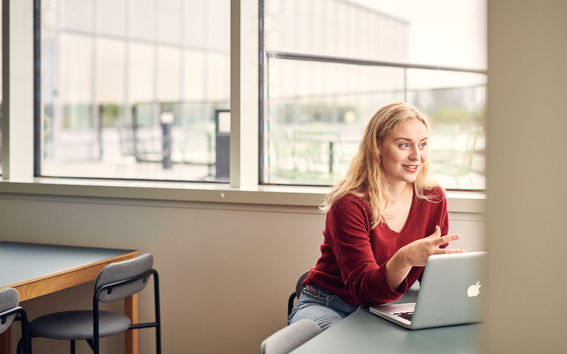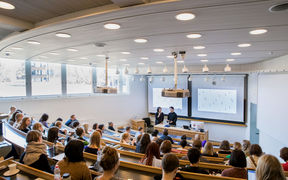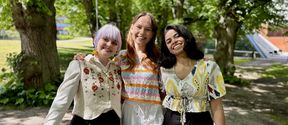Achieving excellent virtual learning experiences rather than simply carrying out remote lectures

At the School of Business’s virtual Learning Café on 22 March, University Lecturer Ville Eloranta from the Department of Management Studies explained how he has added interactive elements to his remote/virtual lectures. Pedagogical Specialist Riikka Evans served as the moderator at the event, which brought together 25 people engaged in teaching work at the School of Business.
‘Don’t just lecture, and especially don’t supervise students through the video connection,’ Ville advised. ‘Instead of lecturing, I work with students to co-create knowledge for each theme. Co-creation may be a rather worn out term, but it is absolutely essential in my teaching. Instead of having lecture events, I break up and mould the teaching around different weekly topics and assignments. This makes the learning experience varied and multifaceted.’
‘The structure for each topic-based week may be as follows: Monday and Tuesday are for reading up on the topic. On Wednesday, I may ask students to return a summary of the discussions they have had with each other. On Thursday, I focus on the areas that students may not have fully internalised and facilitate discussion about them. On Friday, we then reflect on what we learned. I ask students to synthesize their learning. In other words, instead of designing lectures, I am scripting these types of knowledge co-creation modules.’
Many different and equally good ways of learning
According to Ville, we can better take different learning styles and preferences into account now that we are no longer in the lecture hall. ‘One person likes to listen. Another prefers to do their own independent reading. Another most enjoys engaging in discussions. All of these are possible using virtual tools. Some of the observations made have been quite amusing: I have noticed that many students, for example, like to do the washing up while listening – and there is of course nothing to stop them doing this! In fact, doing domestic work often improves concentration!’
Here is another example: ‘Some students like to read together. I can give them a few articles to read and ask them, after they have finished reading, to underline the points that were most difficult to understand. These points can then be tackled in group discussions.’
Eloranta continues: ‘It is therefore very important to support different learning preferences. Of course, the challenge is that I do not necessarily know in advance what kind of students are on the course. I try to use different overlapping methods, therefore, while at the same time assessing which ones work best.’
Of course, there are challenges also in the virtual environment. ‘When you are presenting something, you can’t get enough feedback from students because you aren’t able to read their faces and gestures properly, even if the cameras are turned on. It is therefore worth considering whether to make use of pre-recorded presentations. When I do this, then as a rule the recording involves just a brief talk in which I raise and repeat the most important issues. After this, I discuss the topic with the students. This enables proper interaction.’
Associate Professor of Marketing Sanna-Katriina Asikainen commented on the fact that materials can be uploaded in advance to the Perusall platform, for example, and that this enables joint learning. On the other hand, Senior University Lecturer in Information Systems Science Johanna Bragge shared her experience that even though she pre-records videos and lectures, as many as half of the students do not regularly view them in accordance with the weekly schedule. This is case even if students receive extra points for responding to quizzes included in the videos. Ville was also aware of this challenge, and said that he tried to solve it by making only short video clips. He also seeks to label each short video as informatively as possible. By doing so, he has succeeded in increasing the viewing figures for his pre-recorded videos.
Using the tools that suit you best
Associate Dean for Teaching and Learning Tomas Falk asked Ville about his experiences with virtual whiteboards such as Jamboard and Flinga. Ville said that he makes active use of them, and that this is also important for preventing Zoom fatigue. ‘In Zoom, we are literally trapped in our own boxes! We need to experience having a common space! I therefore seek to invigorate the learning process by using a variety of whiteboard tools, many of which are available at Aalto. But I nevertheless try to stop it getting too complicated overall. Keep it simple – you don’t always have to seize on the latest technology.’
Riikka Evans agreed with Ville’s view that it is best to use the technology that one is confident and comfortable with. ‘It is definitely worth testing out the tools beforehand so that no unpleasant surprises. Of course, it is good to introduce new tools, as long as you first test them out a few times beforehand. It is also best, of course, to not be startled if technical problems strike, but rather to take a relaxed approach to them and move forward with plan B instead.’
The second presentation was given by Assistant Professor of Accounting David Derichs, who talked about creating scalable, inclusive and effective learning spaces using a VR case experience he created (the first of its kind in business education).
Text: Terhi Ollikainen
Teaching and learning
A landing page for teachers to help them find services and support related to teaching and learning.

- Published:
- Updated:
Read more news

Online AI course could boost study equality
Students at the School of Business believe that mastering Artificial Intelligence (AI) can be beneficial for both academic success and career prospects, as AI becomes increasingly integrated into daily life.
2 027 new students admitted to Aalto University’s Finnish, Swedish bachelor’s programmes
13 500 applied to Aalto University in Finland's spring joint application in 2024
Meet the the Program Assistants that elevate the Aalto University Summer School experience for 250 students from all over the world
Each year, the Aalto University Summer School has grown its operations and course curriculum tremendously.